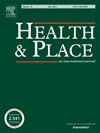基于两步浮动集水区(2SFCA)法的医疗可达性测量中的可修改面积单位问题(MAUP
IF 4.1
2区 医学
Q1 PUBLIC, ENVIRONMENTAL & OCCUPATIONAL HEALTH
引用次数: 0
摘要
广泛使用的两步浮动集水区(2SFCA)法进行医疗可达性测量时,可能会因可修改区域单位问题(MAUP)而产生偏差,而这一问题仍是未知数。本研究通过基于高斯的 2SFCA 方法计算并比较了不同空间尺度下的医疗可达性,以确定尺度效应。我们还比较了乡镇尺度上的各种空间聚合方法,以研究分区效应,包括几何中心、人口中心、政府驻地和混合人口加权平均旅行时间方法。以拉萨市为研究区域,采用基于网格的旅行时间估算方法来反映自然环境的影响。结果表明,2SFCA 方法的应用具有明显的规模效应。使用人口中心点来表示乡镇内的人口空间分布,可以得到更准确的可达性结果,而基于几何中心点测量的可达性可能会有很大偏差。人口加权平均旅行时间法将网格尺度的旅行时间汇总到乡镇尺度,也能确保高精度的可达性测量。在人口数据有限的情况下,人口加权平均旅行时间法和人口中心点法能更有效地减轻对可达性结果的潜在规模效应。这些发现对于研究人员正确应用无障碍方法和支持基于无障碍结果的可靠政策影响非常有价值。本文章由计算机程序翻译,如有差异,请以英文原文为准。
On the Modifiable Areal Unit Problem (MAUP) in healthcare accessibility measurement via the two-step floating catchment area (2SFCA) method
The widely used two-step floating catchment area (2SFCA) method for healthcare accessibility measurement might be biased due to the Modifiable Areal Unit Problem (MAUP), which remains unknown. This study calculates and compares healthcare accessibility via the Gaussian-based 2SFCA method at various spatial scales to identify the scale effects. We also compare various spatial aggregation approaches at the township scale to examine the zoning effects, including geometric centroids, population centroids, government residences and a hybrid population-weighted average travel time approach. Taking Lhasa city as the study area, the grid-based travel time estimation method is adopted to reflect the influence of the physical environment. The results reveal significant scale effects in the application of the 2SFCA method. Using population centroids to represent the spatial distribution of population within townships can yield more accurate accessibility results, while the accessibility measured based on geometric centroids might be considerably biased. The population-weighted average travel time approach, which aggregates grid-scale travel times to the township scale, also ensures high accuracy of accessibility measurement. The population-weighted average travel time approach and the population centroid approach are more effective in mitigating potential scale effects on accessibility results with limited population data. These findings are valuable for researchers to apply accessibility methods properly and support reliable policy implications based on accessibility results.
求助全文
通过发布文献求助,成功后即可免费获取论文全文。
去求助
来源期刊

Health & Place
PUBLIC, ENVIRONMENTAL & OCCUPATIONAL HEALTH-
CiteScore
7.70
自引率
6.20%
发文量
176
审稿时长
29 days
期刊介绍:
he journal is an interdisciplinary journal dedicated to the study of all aspects of health and health care in which place or location matters.
 求助内容:
求助内容: 应助结果提醒方式:
应助结果提醒方式:


